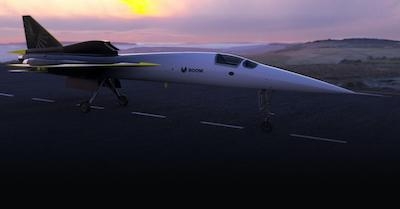First Commercial Aviation OEM To Build Sustainability Into Aircraft Programs From The Ground Up
Boom Supersonic, an aerospace company building history’s fastest supersonic airliner, has announced that its XB-1 test program will be fully carbon neutral through the use of sustainable aviation fuels and carbon offsetting. Boom integrates sustainability considerations into every major company decision and is the first commercial airplane manufacturer to commit to a carbon-neutral test program. XB-1 is Boom’s supersonic demonstrator aircraft designed to prove in-flight the key technologies for safe, efficient and sustainable travel at supersonic speeds, and Boom’s commitment covers all ground and flight testing performed over the lifetime of the XB-1 program.

“Since Boom’s founding, we’ve been on a mission to make the world dramatically more accessible through supersonic travel,” said Blake Scholl, Founder and CEO of Boom. “With our commitment to a carbon-neutral XB-1 test program, we’re laying the groundwork for a sustainable supersonic future with Overture.”
Boom says it is ushering in a new supersonic era where environmental considerations are essential throughout the aircraft’s design, testing and flying. In June 2019, Boom announced its partnership with Prometheus Fuels, one of the most innovative companies in the field of sustainable alternative fuels, to supply carbon-neutral jet fuel during the XB-1 test program. Prometheus’ technology economically removes CO2 from the air and uses clean electricity to turn it into jet fuel. The electricity used in this process comes from renewable sources such as solar and wind, so there are no net carbon emissions from using the fuel. In January 2019, Boom successfully conducted a series of ground tests, running XB-1 engines using sustainable aviation fuels (SAF). These tests, powered by a blend of more than 80% sustainable fuel, gave the company the confidence that XB-1 can safely use SAF in future ground and test flights.
Additionally, in October 2019, Boom created a dedicated environmental and sustainability team, selecting Raymond Russell as its Head of Sustainability. Russell, a former Google Policy Fellow, has been a key player in Boom’s environmental policy and advocacy since 2017. He also represents Boom at technical working groups of the International Civil Aviation Organization Committee on Aviation Environmental Protection (ICAO/CAEP), supporting evaluations of potential global environmental regulations for aviation. Russell and his team manage Boom’s sustainability partnerships and initiatives, including new opportunities for sustainability in aircraft design, sustainable aviation fuels, flight routing, and carbon offsetting. “As a new entrant in aerospace, Boom is making sustainability a core tenet of our aircraft development program,” said Russell. “Thanks to today’s technology, supersonic travel is economically viable, and we are proud to ensure that it’s
environmentally friendly as well.”
Boom is nearing completion of its XB-1 demonstrator, history’s first independently-developed civil supersonic aircraft. The design, build, and test phases of XB-1 are intended to inform the design of Overture, Boom’s supersonic commercial airliner, and lessons from XB-1 have already helped optimize Overture. XB-1 has a planned rollout in summer 2020.
(Image provided with Boom Supersonic news release)
 ANN's Daily Aero-Term (05.17.24): Very High Frequency
ANN's Daily Aero-Term (05.17.24): Very High Frequency ANN's Daily Aero-Linx (05.17.24)
ANN's Daily Aero-Linx (05.17.24) ANN FAQ: Submit a News Story!
ANN FAQ: Submit a News Story! Classic Aero-TV: ANN Visits Wings Over The Rockies Exploration Of Flight
Classic Aero-TV: ANN Visits Wings Over The Rockies Exploration Of Flight Airborne Affordable Flyers 05.16.24: PRA Runway, Wag-Aero Sold, Young Eagles
Airborne Affordable Flyers 05.16.24: PRA Runway, Wag-Aero Sold, Young Eagles



